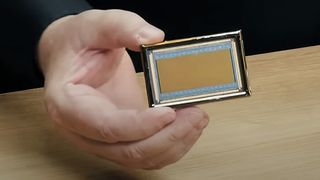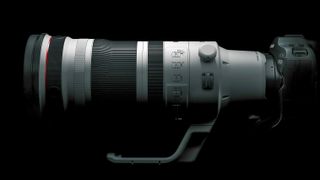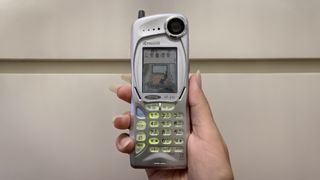It'd be easy to think even the best tripod is now redundant, thanks to all the recent advancements with cameras’ in-body and lens-based optical image stabilization. But we beg to differ.
For long exposures capturing anything from landscapes using 10-stop neutral density filters, to twilight cityscapes and the night sky, a tripod is still an essential bit of kit. They’re also very much needed for keeping your camera still and steady through a sequence of shots, for example when taking exposure-bracketed stills to merge into an HDR (High Dynamic Range) image. And then there’s architectural photography, when you want to set up your camera with supreme precision, or maybe take a series of shots with incremental panning to create panoramas. We could go on, the list is long.
So what do you need to look for when choosing a tripod? Size and weight are key considerations. For versatility, there’s no beating a full-sized tripod with a lofty maximum operating height. Some go further still with a pivoting center column, ideal for macro photography and shooting with really wide-angle lenses. Full-sized carbon fiber tripods tend to be around 25 percent lighter in weight than their aluminum counterparts, making them easier to carry around, and they’re often more resistant to vibration. The flip side is that they’re more expensive to buy.
The maximum load rating is important to bear in mind if you have a relatively hefty camera and big telephoto lenses. Even if you don’t, tripods with a beefier load rating tend to be more sturdy, solid, and stable, and less prone to flexing. A greater number of sections in each leg enables the tripod to fold down smaller but each joint is a potential weak point when it comes to stability, they take longer to set up and fold down, and the bottom legs often tend to be relatively thin and spindly.
If you’re after a tripod that folds down really small, take a look at our separate buying guide on the best travel tripods. And whereas the photography tripods covered in this buying guide aim to give fixed, solid support for stills, free-flowing video capture is another ball game altogether. For that, check out our guide to the best video tripods.
Best tripod: Our top picks
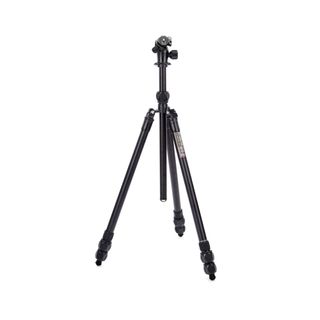
Best overall
Sturdy, tall, yet packs small and won't weigh you down. It's even well priced - what's not to like?!
Read more below

Best for sturdiness
Super-sturdy support that's ideal for heavy camera+lens set-ups, plus you can pivot the center column through a complete 180-degree arc, opening up loads of creative shooting possibilities.
Read more below
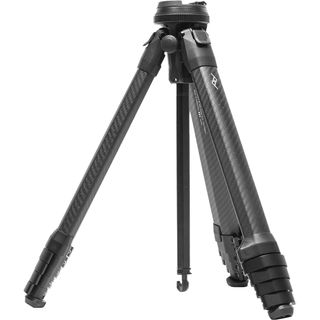
Best compact travel tripod
Super-sturdy support that's ideal for heavy camera+lens set-ups, plus you can pivot the center column through a complete 180-degree arc, opening up loads of creative shooting possibilities.
Read more below
The best tripods in 2024
Why you can trust Digital Camera World
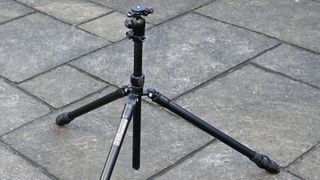
Specifications
Reasons to buy
Reasons to avoid
This is the newer, ‘aluminum’ version of one of our all-time favorite tripods – the carbon fiber 3 Legged Thing Winston 2.0. Although advertised as aluminum, the leg sections are crafted from aerospace-grade magnesium alloy. The net result is that it’s still pretty lightweight for a tripod with a towering maximum height of almost two meters. It folds down pretty small too, thanks to swing-up legs that are more usually associated with travel tripods. You can buy the legs on their own but the full kit with the AirHed Pro 2.0 ball head is the one to go for. They’re simply made for each other and a match made in tripod heaven. The head features an Arca-Swiss compatible quick-release plate, but there’s no D-ring so you have to fasten it to your camera or long lens with a coin or the supplied tool.
Read our full 3 Legged Thing Charles 2.0 review for more details.
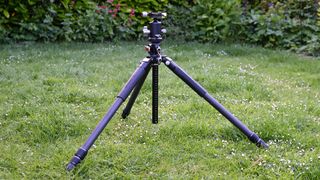
Specifications
Reasons to buy
Reasons to avoid
This relatively new tripod takes it to the Manfrotto 055 with a super-sturdy carbon fiber build using large-diameter three-section legs and a pivoting center column. The Vanguard actually goes one better, in that you can pivot the center column through a complete 180-degree arc instead of just using it in vertical or horizontal orientations. It also comes with an extra platform that attaches to the center column, so you can mount two cameras at the same time, or a camera and another accessory like an LED light. The ball head supplied with the kit is a great match for the legs, being very versatile and particularly sturdy and robust.
Read our full Vanguard VEO 3+ 303CBS review for more details.
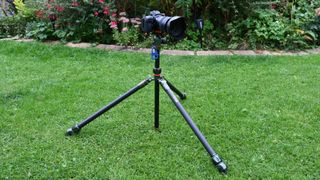
Specifications
Reasons to buy
Reasons to avoid
3 Legged Thing is a UK-based manufacturer with a deserved reputation among photographers for making attractive, ultra-sturdy tripods. The Winston 2.0, one of the most recent models, is particularly impressive, able to extend to almost 2m in height, but also fold down to 61cm.
Smartly design with clever engineering, the Winston 2.0 is quick to deploy and has a solid build designed to resist flexing and vibration. Its leg and center-column sections are constructed from 8-layer carbon fibre, making them lightweight but solid, and the leg diameter is thick all the way down. Pair it with 3 Legged Thing's AirHed Pro and you've got a truly exemplary tripod support system on your hands.
The 3 Legged Thing Winston 2.0 is small and light enough to be useful as a travel tripod, while also being strong enough for even the heaviest of professional camera setups.
Read our full 3 Legged Thing Winston 2.0 review for more details

Specifications
Reasons to buy
Reasons to avoid
The Vanguard Veo 3+ 263AB is a full-size tripod with three sections, so it doesn't fold down that small but it's quick to set up and reaches a good height. It doesn’t feel that heavy for an aluminum tripod, and if you want to shave off a little weight, there is a carbon fibre (CB) version that’s only a little more expensive.
The design and build are first class, the angled column works brilliantly and all the controls and adjustments have a smoothness and precision that you would expect to cost a lot more than this. If you don't need portability but you do need height, adaptability, rigidity, and quality, this is ideal
Read our full Vanguard Veo 3+ 263AB review for more details
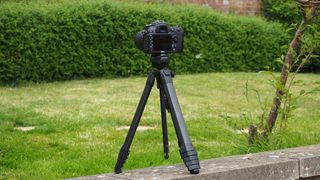
Specifications
Reasons to buy
Reasons to avoid
It's the first tripod Peak Design has made, and the carbon fiber version we looked at costs more than practically any of its rivals except a Gitzo, so it had better be good. There is an aluminum version that's a massive 40% cheaper, however, which has all the same design features but just a little less vibration resistance.
The Peak Design Travel Tripod isn't just useful for travel. It packs down to just 39cm in length, so it's easy to carry on outings and when hiking across the country, but it also extends high enough to work as a regular everyday tripod, and it has all the rigidity of a regular tripod too. The low-profile ball head is simple but brilliant, there's a phone holder hidden inside the center column.
It's certainly no bargain, even the aluminum version, but for its combination of design finesse, compactness, and rigidity, the Peak Design Travel Tripod is out on its own.
Read our full Peak Design Travel Tripod review for more details

Specifications
Reasons to buy
Reasons to avoid
The Benro Rhino FRHN34CVX30 is at the top of the size spectrum for a ‘travel’ tripod, but its simplicity, rigidity, and ease of use mark it out as a top choice for landscape shooters, hikers and any outdoor photographer who needs to travel light but still have the best support possible – and Benro’s VX ball head with its additional pan axis is just brilliant.
If you need to pack a small camera support for city breaks and street photography, take a look at the Peak Design travel tripod, or the smaller Benro Rhino FRHN05CVX20, but if you need a portable tripod that doesn't sacrifice height or rigidity, the Rhino FRHN34CVX30 is the bee's knees.
Read our full Benro Rhino FRHN34CVX30 review for more details
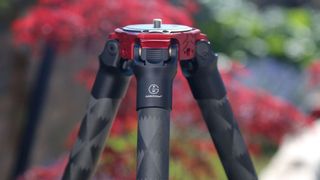
Specifications
Reasons to buy
Reasons to avoid
The ProMediaGear TR344L is a really expensive and very impressive tripod that’s been made to suit the needs of dedicated landscape photographers. Sure, it’s way over most budgets and it’s over-specified for what it is for most photographers, but if you’re going to be spending the next decade outdoors in all kinds of weather and you don’t want to spend your time cursing an awkward or heavy tripod then the durable and quick to set-up and pack-up TR344L is worth the investment.
Read our full ProMediaGear TR344L Pro-Stix review for more details
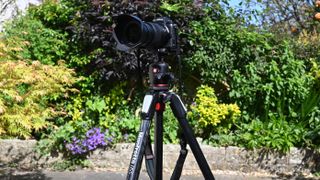
Specifications
Reasons to buy
Reasons to avoid
There’s an aluminum version of this tripod which is available as just a set of legs, or as a complete kit with either an XPRO Ball Head or XPRO 3-Way Head. The carbon fiber edition is naturally more expensive but feels much more of a luxury item, is nearly half a kilogram lighter and, in our tests, proved more resistant to vibration. As well as giving really solid support, it features a pivoting center column that you can use as a horizontal boom. It’s great for macro shooting and for stopping the tripod feet from creeping into the shot when you’re using ultra-wide-angle lenses.
Read our full Manfrotto 055CXPRO3 review for more details.
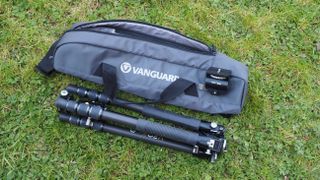
Specifications
Reasons to buy
Reasons to avoid
The Vanguard VEO 3T+ 264CB is pitched to those who want a travel-friendly tripod but don't want to compromise on features and functionality. Might seem like a pipedream, but this relatively small tripod does a good job, with loads of useful features like its multi-angle center column, and the bundled VEO MA-1 multi-mount, which allows you to attach other accessories or even another body.
All this is wrapped up in a tripod with seriously high-quality construction, as you'd expect from Vanguard, and it comes at a pretty competitive price. The only real downside is that despite its "travel" billing, the VEO 3T+ 264CB is still pretty hefty. It's 48cm long when folded and the whole ensemble is 2.275kg, so it's not exactly something you could carry around freely.
Read our full Vanguard VEO 3T+ 264CB Review for more details
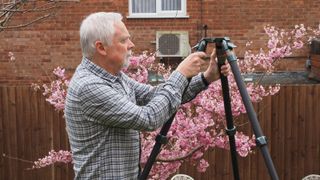
Specifications
Reasons to buy
Reasons to avoid
Make no mistake, the 3 Legged Think Nicky is a professional-level tripod for a discerning audience. Made for photographers and videographers working with heavier kits, it’s strong, straightforward to use, tall, and adaptable. It’s a base, not a kit, however, so unless you have these things already (many photographers will), you’ll also need to budget for a head and, for video, perhaps a leveling bowl too
It's probably worth repeating this key thing about the Nicky. It is a tripod to which you add your own head, leveling bowl, or other accessories – it's not complete in itself. It’s ideal for photographers and videographers who already have these things and just want a better tripod, but if do need all these extras too, then you’re going to need to get your wallet out – and keep it out..
Read our full 3 Legged Think Nicky review for more details
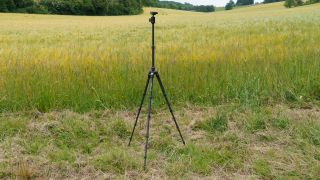
Specifications
Reasons to buy
Reasons to avoid
Vanguard states its VEO 3T range "includes everything you’d expect in a high-quality travel tripod, with additional features that help anyone get the best result for their video with a camera or smartphone." Beefier models in the range can support an impressive 12kg, but we reckon this 235CBP version with its 8kg load rating is more than up to the job.
The lower capacity also results in a more compact 41cm closed length, while carbon construction keeps total weight down to a reasonable 1.6kg. The included head has a removable pan handle to allow greater control while filming, and a new Arca-compatible quick-release plate can hold a camera or smartphone up to 85mm wide, plus there's even a Bluetooth remote control for IOS or Android.
Read our full Vanguard VEO 3T 235CBP review for more details

12. Manfrotto 190XPro4
Specifications
Reasons to buy
Reasons to avoid
This four-section Manfrotto 190XPro4 ball head kit is a full-sized tripod with an XPro ball head included. It's got everything you need and is going to be suitable for a huge majority of photographers.
Reaching a full operating height of 175cm while also shrinking down to a modest folded height of 57cm, the Manfrotto 190XPro4 is great for all situations. It's a relatively recent refresh of a popular Manfrotto model and has a 90-degree pivot facility which means it can be swapped to a horizontal boom mode within seconds. The leg sections also use a new innovative locking lever design that allows them to be released from either side.
Sturdy as a rock, even when at its maximum height, the Manfrotto 190XPro4 is the archetypal photographer's tripod; it's very difficult to imagine the kind of photographer for whom this would not be suitable. Its XPro ball head is also state-of-the-art, with an adjustable friction damper. There are cheaper tripods on this list, but if the Manfrotto 190XPro4 is within your budget, we can recommend it without hesitation.

Specifications
Reasons to buy
Reasons to avoid
Sometimes, only the best will do. The Gitzo GT5563GS is not going to be for every photographer – or even, arguably, for that many photographers. But it is the best and biggest tripod you can get right now, and if you need the maximum in terms of height, this is your buy.
The Gitzo GT5563GS is nicknamed “Giant” for a reason. It extends to an absolutely whopping maximum height of 278cm, which is taller than anyone alive and can carry a humongous 40kg of camera gear. This is more capacity than anyone could conceivably need – really it’s more than double what anyone could conceivably need.
The tripod isn’t just a one-trick pony though; it’s also smartly designed, with a carbon fibre build and incredible flexibility. The lowest height it can work at is as small as 10cm! The carbon fibre build keeps it lighter than you’d expect for a tripod of this strength and complexity, and the quality throughout is just top-notch – as reflected by the price.
Read our full Gitzo GT5563GS Systematic Series 5 Carbon Fiber Tripod (Giant) review for more details
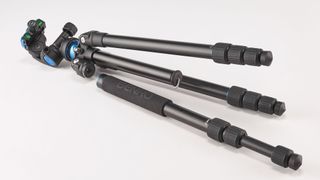
14. Benro Mach3 TMA27C + B1 head
Specifications
Reasons to buy
Reasons to avoid
With so many recent tripods going out of their way to pack in fancy features that you’ll probably never need, it’s nice to see one that concentrates on simple, solid support. This Benro is an entirely conventional affair, based on three-section legs that don’t swing up to reduce the stowage size, and there’s no pivoting center column. The result is a traditional carbon fiber tripod that’s super-quick and easy to set up. It’s not without trickery though, as the Benro comes complete with a low-level adapter for shooting at really low heights without needing to invert the camera, and you can unscrew one of the legs to use it as a monopod with the center column and ball head. Speaking of which, the head is sold separately and we’d go for the Benro B1 Ball Head, which is a perfect match.
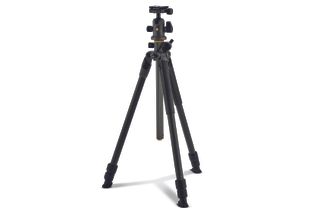
15. Vanguard ALTA PRO 2+ 263CB 100
Specifications
Reasons to buy
Reasons to avoid
This complete carbon fiber tripod kit with a ball head plays the numbers game with great success. It has calibrated markings for the four-angle legs, 7-angle pivoting center column, and a 360-degree panning ball head with an independent pan-release lock. With legs that don’t swing upwards for stowage, and have three rather than four sections, the tripod is quick and easy to set up but the folded height is quite tall. The pivoting center column can be locked at various angles through a complete 180-degree arc and there’s a 3/8-inch threaded socket on the spider for attaching accessories like an LED light or microphone. All in all, it’s very versatile, solid, and easy to use.
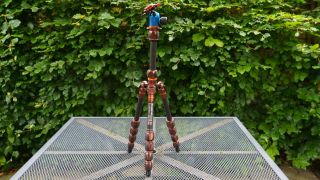
Specifications
Reasons to buy
Reasons to avoid
The Leo is no ordinary tripod. It folds down to just 35cm in length but opens out to offer a maximum height of 146cm and a huge payload capacity of 30kg. It has a detachable monopod leg which can also be used as a microphone or camera boom, a Tri-Mount system for adding accessories, and an innovative two-section center column.
You can buy the legs on their own but we’d recommend getting it as a kit with 3 Legged Thing’s new and improved AirHed Pro Lever ball head. We love (we LOVE) the optional Vanz kit, a set of three replacement feet/legs.
You unscrew the regular legs and screw these in to get the toughest, gnarliest table-top mini tripod you've ever seen. The Leo 2 is not the smallest travel tripod you can get, and not the cheapest, but its ratio of folded length to maximum height, combined with its all-round versatility, make it one of the best.
See our full 3 Legged Thing Leo review for more details
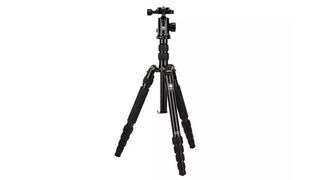
17. Sirui NT-1005X/E-10
Specifications
Reasons to buy
Reasons to avoid
When it comes to folding down small for compact carriage, the Sirui NT-1005X reigns supreme. It’s definitely designed to be as small as possible, not only featuring five-section legs with a swing-up facility but also incorporating a two-section extending centre column. The result is a generally adequate maximum operating height of 150cm, and a particularly tiny folded height of 36cm. That’s only about half the folded height of the Manfrotto 290 kit. And despite its aluminium build, the Sirui is only 10g heavier than the Novo carbon kit.
Build quality is very good: the Sirui feels solid and robust, despite its lightweight construction. It remains rigid and steady even at the maximum operating height, with all five leg sections fully extended and both sections of the centre column at full reach. Three locking leg angles are available, and there’s the usual facility to remove one leg and the centre column for use as a monopod. And there are no retractable or interchangeable metal spikes for the feet, but the rubber pads are of good quality.
Set-up on the NT-1005X/E-10 is quick and easy, from the non-slip feet to the ball head with its Arca-Swiss compatible quick-release plate. All adjustments are smooth but lock solidly – although the head lacks an independent friction damper – and the swing-up legs can be locked at three alternative angles. The maximum operating height is a little meagre, but the carrying size is incredibly small. If ultra-compact carriage is high on your priority list, the Sirui is a very desirable tripod indeed.
How to choose the best tripod
Aluminum or carbon fiber?
These are the two most common materials used for tripod legs. Aluminum tripods are cheaper but weigh more. They’re ideal if you want the maximum stability for your money. Carbon-fiber tripods cost more but weigh less and absorb vibration better. They’re good if cost is less important than weight – but the price premium can be substantial.
How much height do I need?
Shots aren’t always improved by shooting them at eye level (lower often works best), but it’s also about getting a comfortable working height. Check the height without the column being extended, if you can.
Check the folded length
The weight of a tripod is important if you’re going to carry it any distance, but so is its folded length. If it’s too long to strap to your bag, and it’s unwieldy in trains or climbing over stiles, then it’s going to put you off taking it anywhere. Many so-called ‘travel’ tripods have legs that fold upwards for storage and completely enclose the head. This makes them smaller and neater when folded and easier to carry around.
How many leg sections?
Tripod legs may have three, four, or five sections. A larger number of sections means the tripod is shorter and more portable when it’s folded, but it will usually take a little longer to set up and may well not be quite as stable.
What type of leg locks?
These come in two main types: twist locks and flip locks. Twist locks take up less space and are generally a little quicker to use – you can often unlock all the leg sections in a single movement when you’re setting the tripod up. Flip locks are operated individually and may be a bit slower. Try both types to see which you prefer.
Leg angles
Most tripods have legs that can be angled independently – which is particularly useful when working on sloping sites or in cramped areas. The standard leg angle will be fine for regular use, but it’s often useful to splay one or more legs outwards on uneven surfaces or to rest them on walls, say. Splaying out all three legs will allow you to shoot from a much lower angle.
What type of head should I get?
Sometimes the tripod head is included with the legs, sometimes not. You can change one head for another depending on how you like to work, as the connection is standardized. Ball heads and three-way heads are the most common types. Ball heads are compact and quick to use, but not so good for small, controlled movements. Three-way heads are larger but allow precise adjustments for each axis independently.
You can also find other, specialist heads. Geared heads allow you to make fine adjustments to camera angles. Gimbal heads are designed for use with long, heavy lenses – which can otherwise can unbalance a tripod. And then there are specialist heads for panoramas and video too.
Attaching your camera
Most tripods are sold with heads, and most heads have a quick-release plate so that you can detach the camera in moments for handheld shots. The Arca Swiss-compatible plate is by far the most common, meaning you can swap between different tripod heads, even if they're made by different manufacturers. However some makers, notably Manfrotto, make their own bespoke QR plates, which can be a nuisance if you have two or more tripods from different makers.
Extra features
Detachable monopod legs: These sound really useful – a detachable leg you can then screw into the center column to make a monopod. In practice, we find these often lack the rigidity of a 'real' monopod unless you're starting with a particularly substantial tripod.
Center column: Not all tripods come with a center column, but most do. You can extend this upwards to increase the height of the camera, although this introduces extra wobble. On some tripods, the center column can be rotated to produce an angled boom, which is perfect for overhead shots, macro work, and tabletop photography. Using the center column does reduce the stability of the tripod, however, so is best avoided with long exposures.
Bowl base: This is a video-specific feature that allows you to get the base level without having to make a whole series of tiny adjustments to the leg length. A level base is essential for a video where you want to make panning movements, and the best video tripods come with bowl or leveling bases as standard.
Types of feet: Rubber feet are fine on most surfaces but best on carpets and wooden floors, where you don’t want to cause damage. Metal spikes are good for soft and uneven ground. Some tripods have rubber feet, which can be screwed back to reveal spikes.
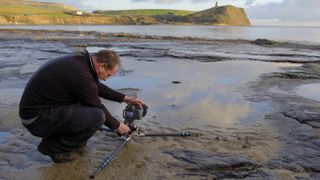
How we test tripods
We measure the maximum operating height of each tripod and its folded height for carrying, complete with head attached. We also measure the combined weight of each set of tripod legs and head, using electronic scales, and measure the diameter of all leg sections, from the widest to the thinnest, using digital calipers.
We check the ease of use, smoothness and precision of all available adjustments in each set of tripod legs and heads. This ranges from adjusting leg sections and pivot facilities (where available), to the locking mechanisms of the head, as well as independent pan and friction damping adjustments, where fitted.
To check overall stability, we shoot with a range of camera bodies fitted with wide-angle, standard, telephoto and macro lenses. We look for good resistance to flexing and vibrations throughout the whole range of operating heights, including the tallest available settings with the legs and center column fully extended.



